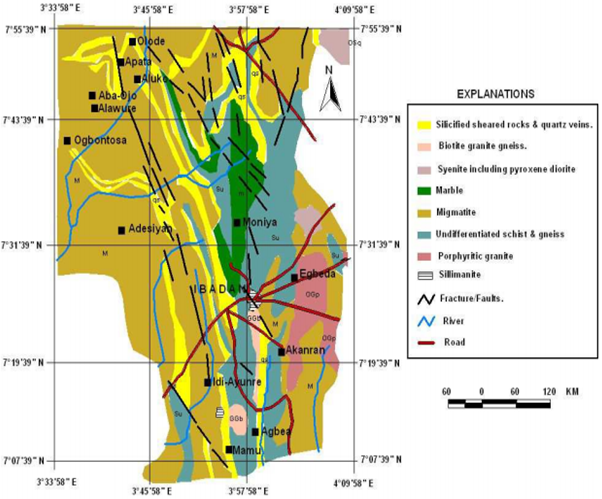Investigation of Groundwater Contamination from Akanran Open Waste Dumpsite, Ibadan, South-Western Nigeria, using Geoelectrical and Geochemical Techniques
Keywords:
Contaminants, Geochemical, Leachate, Resistivity, Solid waste dumpsiteAbstract
In recent times, large waste is produced especially in an urban area due to population with careless handling which calls for worries. Hence, the study determines the effect of Akanran dumpsite on the groundwater quality for drinking and domestic purposes. It employs the geophysical and geochemical methods. Wenner configuration was adopted with constant electrode separation ranging from 5 to 25 m to acquire five profiles within and outside the dumpsite and processed using DIPROWIN 4.01 software. Soil and water samples were collected and analysed. The 2-D pseudosection revealed a very low resistivity value which is less than 10 ohm-meter and is suspected to be leachate infiltration which migrates to a depth of 7 m. The results of soil analysis show that clay ranges between 9.61 - 18.8 %., silt between 9.27 – 19.7 % and an average bulk density of 1.48 (relatively high for a sandy loam) which suggests that infiltration of the leachate is minimal. The pH of the water sample analysis obtained is 6.9, suggesting acidic concentrates in the groundwater of the study area. However, this pH value for drinking water is within the permissible level of 6.5 – 8.5 indicating that the groundwater in the study area is suitable for drinking and also for other purposes. A Nitrate level of 2.56 mg/l in the water sample falls within 50.0 mg/l, and nitrite level of 0.09 mg/l which is moderate when compared to the permissible level limit of 0.20 mg/l. The concentration of heavy metals in hand-dug well sample from Akanran dumpsite are Zn (1.81 mg/l), Cu (0.38 mg/l), Cr (0.003 mg/l) which are within the permissible level limit and Pb (0.21 mg/l) which recorded high metal concentration which may suggest that the dumpsite contain waste metals which may leach down the soil. In conclusion, the groundwater in the area of the survey is safe and there is possible contamination with time.

Published
How to Cite
Issue
Section
Copyright (c) 2021 Journal of the Nigerian Society of Physical Sciences

This work is licensed under a Creative Commons Attribution 4.0 International License.
How to Cite
Most read articles by the same author(s)
- J. O. Coker, H. H. Akpan, A. O. Atilade, O. F. Ojo, Seasonal Comparison of Potential Groundwater Aquifer in Ijebu-Ife, South-West, Nigeria, using Dipole-Dipole Array and Electromagnetic Methods , Journal of the Nigerian Society of Physical Sciences: Volume 2, Issue 4, November 2020







